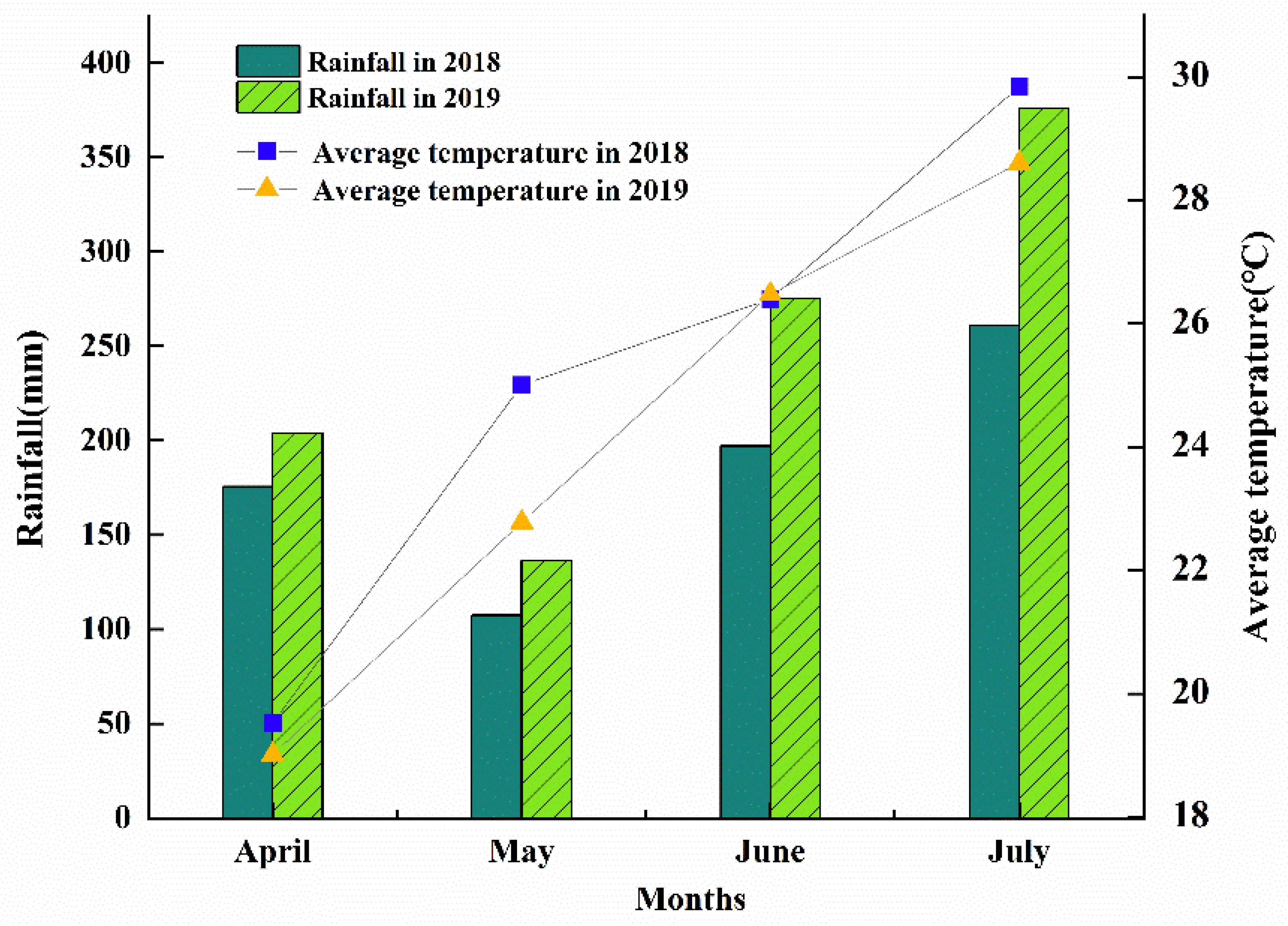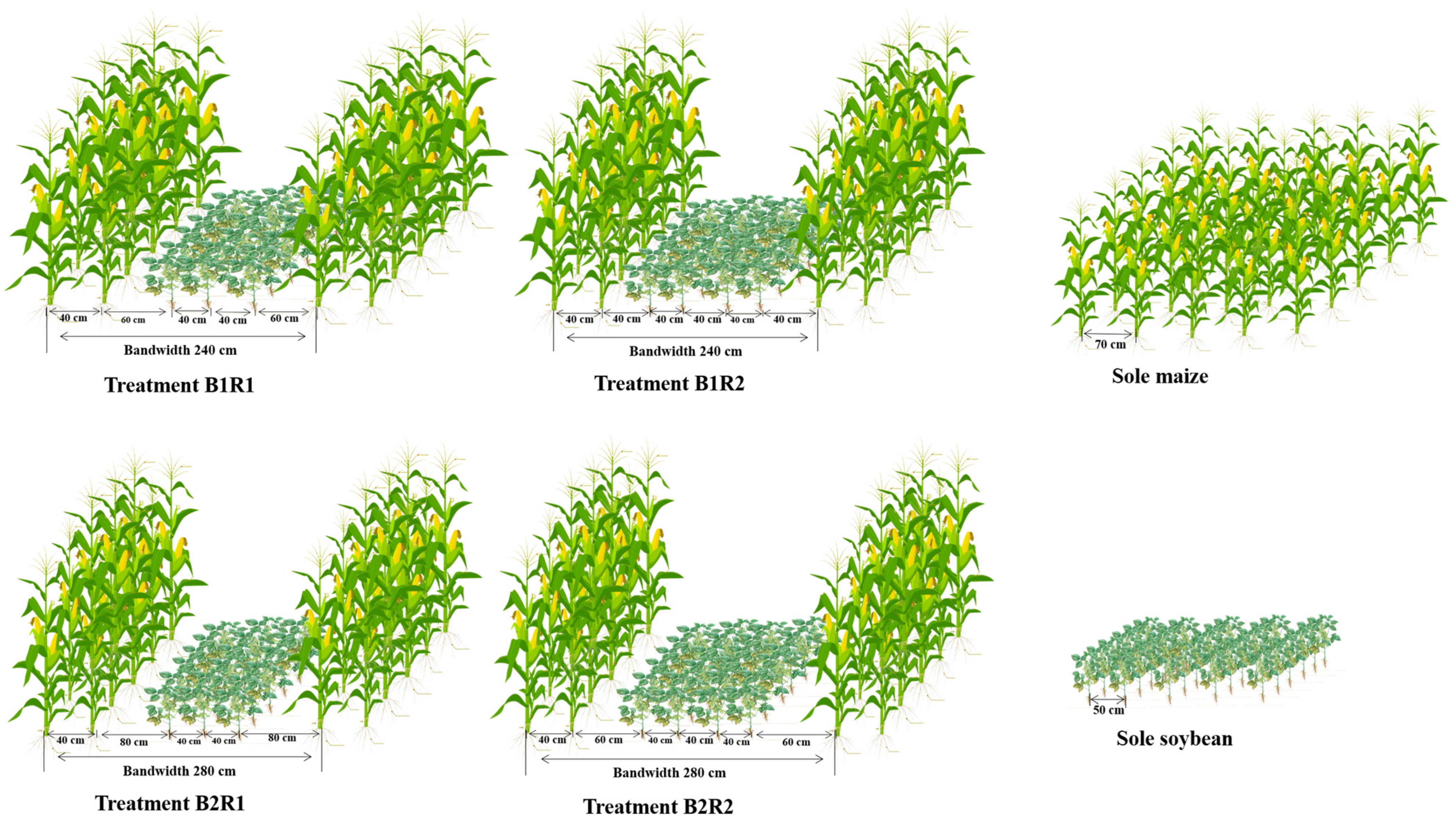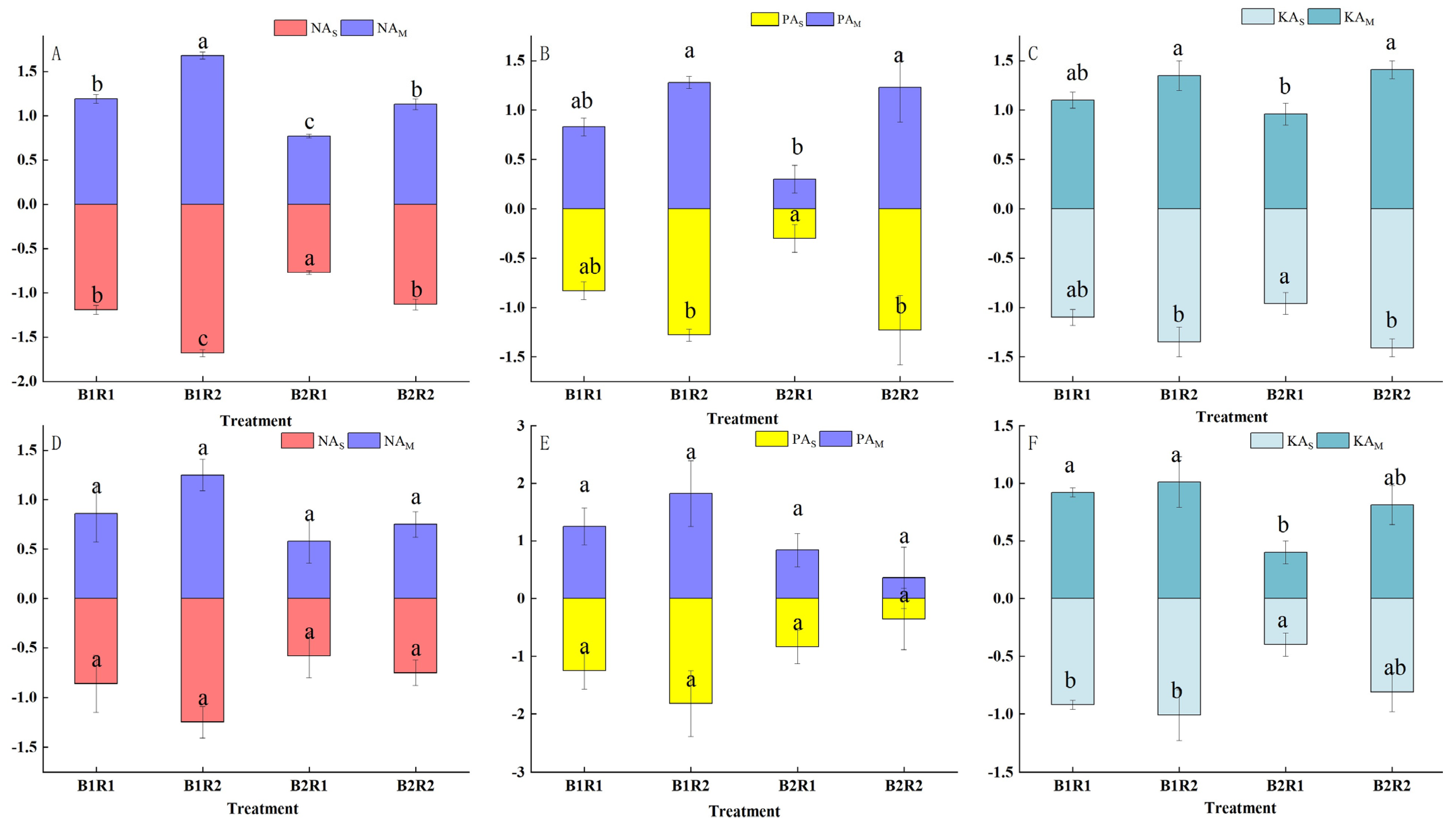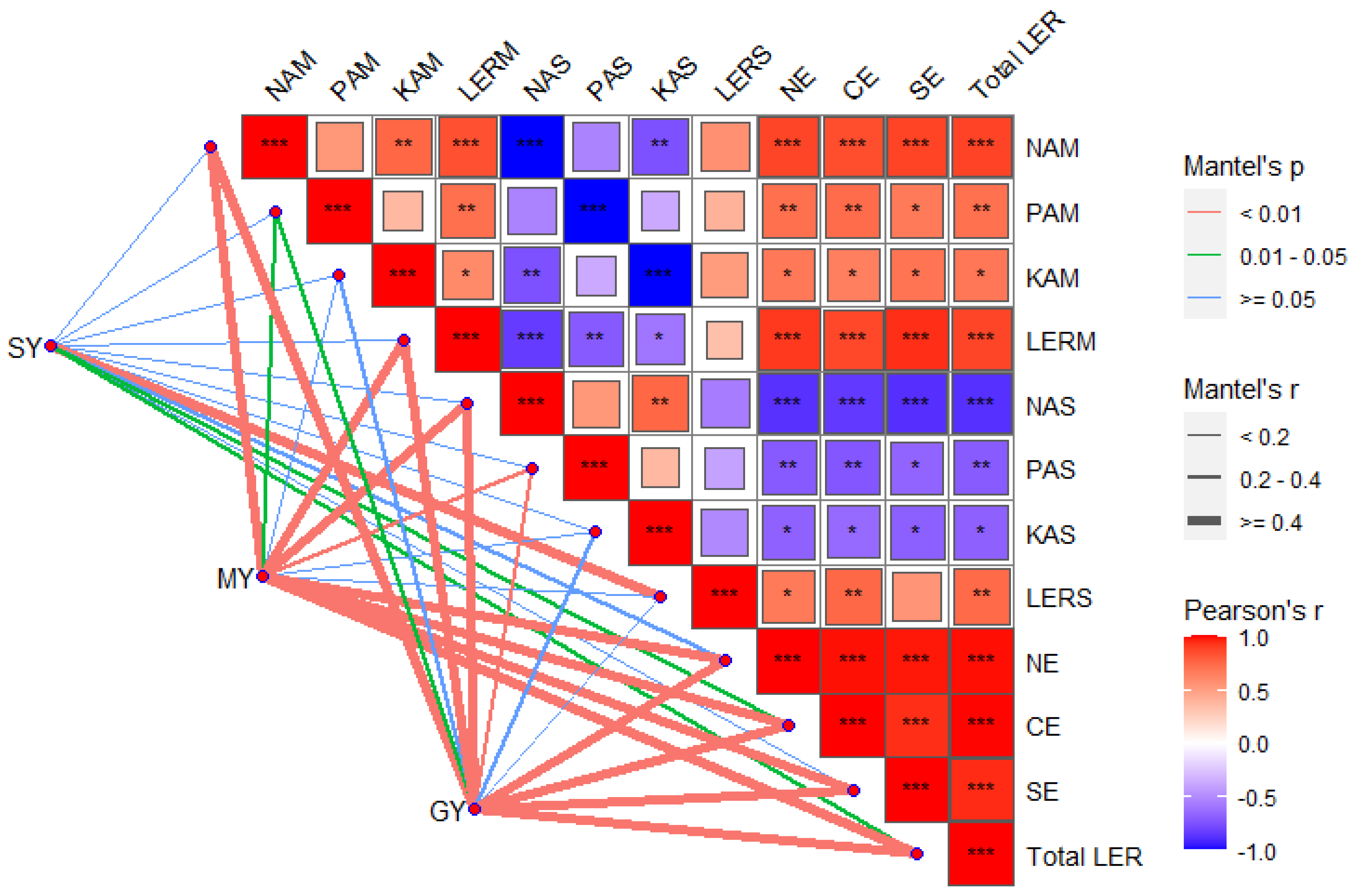Bandwidth Row Ratio Configuration Affect Interspecific Effects and Land Productivity in Maize–Soybean Intercropping System
Abstract
1. Introduction
2. Materials and Methods
2.1. Site Description
2.2. Experimental Design and Field Management
2.3. Data Collection and Measurements
2.3.1. Grain Yield and N, P and K Content
2.3.2. Nutrient Accumulation
2.3.3. Intercropping Advantage
- (1)
- Land equivalent ratio (LER): as a measure of yield advantage [25].
- (2)
- Nitrogen equivalent ratio (NER): As a measure of nitrogen uptake advantage in crops.
- (3)
- Net effect (NE), complementarity effect (CE), and select effect (SE): The NE includes two components: SE and CE [18].
- (4)
- Nutrient Aggressivity (NA): indicates the relative nitrogen uptake of intercrop A compared to the advantage of nitrogen uptake of intercrop B.
2.4. Statistical Analysis
3. Results
3.1. Effect of Different MSI Patterns on Crops Nutrients Accumulation
3.2. Effect of Different MSI on Crop Intercrop Advantage
3.3. Effects of Different MSI on Interspecific Relationships of Crops
3.4. Effects of Different MSI Patterns for Crop Yield
3.5. Effect of Different MSI Patterns on NE, SE and CE
3.6. Correlation Analysis of Intercropped Crops on Nutrient Aggressivity and Land Productivity
4. Discussion
4.1. Different Planting Patterns in Response to Land Productivity
4.2. Response of Different Planting Patterns to the Competitive of N, P and K in Crops
4.3. Response of Interspecific Effect to Crop Yield
5. Conclusions
Author Contributions
Funding
Data Availability Statement
Acknowledgments
Conflicts of Interest
References
- FAO. The Future of Food and Agriculture: Trends and Challenges; FAO: Rome, Italy, 2017. [Google Scholar]
- Gao, C.X. Genome engineering for crop improvement and future agriculture. Cell 2021, 184, 1621–1635. [Google Scholar] [CrossRef] [PubMed]
- Feng, L.; Tang, H.Y.; Pu, T.; Chen, G.P.; Liang, B.; Yang, W.Y.; Wang, X.C. Maize soybean intercropping: A bibliometric analysis of 30 years of research publication. Agron. J. 2022, 114, 3377–3388. [Google Scholar] [CrossRef]
- Li, L.; Li, S.M.; Sun, J.H.; Zhou, L.L.; Bao, X.G.; Zhang, H.G.; Zhang, F.S. Diversity enhances agricultural productivity via rhizosphere phosphorus facilitation on phosphorus-deficient soils. Proc. Natl. Acad. Sci. USA 2007, 104, 11192–11196. [Google Scholar] [CrossRef] [PubMed]
- Du, J.B.; Han, T.F.; Gai, J.Y.; Yong, T.W.; Sun, X.; Wang, X.C.; Yang, F.; Liu, J.; Shu, K.; Liu, W.G.; et al. Maize-soybean strip intercropping: Achieved a balance between high productivity and sustainability. J. Integr. Agric. 2018, 17, 747–754. [Google Scholar] [CrossRef]
- Li, X.F.; Wang, Z.G.; Bao, X.G.; Sun, J.H.; Yang, S.C.; Wang, P.; Wang, C.B.; Wu, J.P.; Liu, X.R.; Tian, X.L.; et al. Long-term increased grain yield and soil fertility from intercropping. Nat. Sustain. 2021, 4, 943–950. [Google Scholar] [CrossRef]
- Feng, L.; Yang, W.T.; Zhou, Q.; Tang, H.Y.; Ma, Q.Y.; Huang, G.Q.; Wang, S.B. Effects of interspecific competition on crop yield and nitrogen utilisation in maize-soybean intercropping system. Plant Soil Environ. 2021, 67, 460–467. [Google Scholar] [CrossRef]
- Yin, W.; Chai, Q.; Zhao, C.; Yu, A.Z.; Fan, Z.L.; Hu, F.L.; Fan, H.; Guo, Y.; Coulter, J.A. Water utilization in intercropping: A review. Agric. Water Manag. 2020, 241, 106335. [Google Scholar] [CrossRef]
- Yang, H.; Zhang, W.P.; Li, L. Intercropping: Feed more people and build more sustainable agroecosystems. Front. Agric. Sci. Eng. 2020, 3, 373–386. [Google Scholar] [CrossRef]
- Chen, X.; Chen, H.Y.H.; Chang, S.X. Meta-analysis shows that plant mixtures increase soil phosphorus availability and plant productivity in diverse ecosystems. Nat. Ecol. Evol. 2022, 6, 1112–1121. [Google Scholar] [CrossRef]
- Cappelli, S.L.; Domeignoz-Horta, L.A.; Loaiza, V.; Laine, A.L. Plant biodiversity promotes sustainable agriculture directly and via belowground effects. Trends Plant Sci. 2022, 7, 674–687. [Google Scholar] [CrossRef]
- Zhao, C.; Chai, Q.; Zhao, Y.H.; Mu, Y.P.; Zhang, Y.; Yu, A.Z.; Feng, F.X.; Liu, C.; Yin, W.; Hu, F.L. Interspecific competition and complementation is a function of N management in maize-pea intercropping systems. Crop Sci. 2016, 56, 3286–3294. [Google Scholar] [CrossRef]
- Zhang, F.S.; Li, L. Using competitive and facilitative interactions in intercropping systems enhances crop productivity and nutrient-use efficiency. Plant Soil 2003, 248, 305–312. [Google Scholar] [CrossRef]
- Zhang, D.S.; Sun, Z.X.; Feng, L.S.; Bai, W.; Yang, N.; Zhang, Z.; Du, G.J.; Feng, C.; Cai, Q.; Wang, Q.; et al. Maize plant density affects yield, growth and source-sink relationship of crops in maize/peanut intercropping. Field Crops Res. 2020, 257, 107926. [Google Scholar] [CrossRef]
- Fan, Y.F.; Yang, F.; Liu, Q.L.; Chen, J.X.; Wang, R.; Luo, S.L.; Yang, W.Y. Effects of shading on leaf structure and photosynthetic fluorescence characteristics of soybean seedlings in maize-soybean relay intercropping system. Acta Agron. Sin. 2017, 43, 277–285. [Google Scholar] [CrossRef]
- Liu, G.; Yang, Y.; Guo, X.; Liu, W.M.; Xie, R.Z.; Ming, B.; Xue, J.; Wang, K.R.; Li, S.K.; Hou, P. Coordinating maize source and sink relationship to achieve yield potential of 22.5 Mg ha−1. Field Crops Res. 2022, 283, 108544. [Google Scholar] [CrossRef]
- Wang, G.; Li, X.; Xi, X.; Cong, W.F. Crop diversification reinforces soil microbiome functions and soil health. Plant Soil 2022, 476, 375–383. [Google Scholar] [CrossRef]
- Zhang, W.P.; Gao, S.N.; Li, Z.X.; Xu, H.S.; Yang, H.; Yang, X.; Fan, H.X.; Su, Y.; Fornara, D.; Li, L. Shifts from complementarity to select effects maintain high productivity in maize/legume intercropping systems. J. Appl. Ecol. 2021, 58, 2603–2613. [Google Scholar] [CrossRef]
- Clark, A.T.; Barry, K.E.; Roscher, C.; Buchmann, T.; Loreau, M.; Harpole, W.S. How to estimate complementarity and select effects from an incomplete sample of species. Methods Ecol. Evol. 2019, 10, 2141–2152. [Google Scholar] [CrossRef]
- Tilman, D.; Knops, J.; Wedin, D.; Reich, P.; Ritchie, M.; Siemann, E. The influence of functional diversity and composition on ecosystem processes. Science 1997, 277, 1300–1302. [Google Scholar] [CrossRef]
- Li, L.; Tilman, D.; Lambers, H.; Zhang, F.S. Plant diversity and overyielding: Insights from belowground facilitation of inter- cropping in agriculture. New Phytol. 2014, 203, 63–69. [Google Scholar] [CrossRef] [PubMed]
- Cahill, J.J.F.; McNickle, G.G.; Haag, J.J.; Lamb, E.G.; Nyanumba, S.M.; St Clair, C.C. Plants integrate information about nutrients and neighbors. Science 2010, 328, 1657. [Google Scholar] [CrossRef] [PubMed]
- Fridley, J.D. The influence of species diversity on ecosystem productivity: How, where, and why? Oikos 2001, 93, 514–526. [Google Scholar] [CrossRef]
- Zhang, W.P.; Liu, G.C.; Sun, J.H.; Fornara, D.; Zhang, L.Z.; Zhang, F.F.; Li, L. Temporal dynamics of nutrient uptake by neighbouring plant species: Evidence from intercropping. Funct. Ecol. 2017, 31, 469–479. [Google Scholar] [CrossRef]
- Raza, M.; Gul, H.; Wang, J.; Yasin, H.S.; Qin, R.J.; Khalid, M.H.B.; Naeem, M.; Feng, L.Y.; Iqbal, N.; Gitari, H.; et al. Land productivity and water use efficiency of maize-soybean strip intercropping systems in semi-arid areas: A case study in Punjab Province, Pakistan. J. Clean. Prod. 2021, 308, 127282. [Google Scholar] [CrossRef]
- Qian, X.; Zang, H.D.; Xu, H.H.; Hu, Y.G.; Ren, C.Z.; Guo, L.C.; Wang, C.L.; Zeng, Z.H. Relay strip intercropping of oat with maize, sunflower and mung bean in semi-arid regions of Northeast China: Yield advantages and economic benefits. Field Crops Res. 2018, 223, 33–40. [Google Scholar] [CrossRef]
- Li, C.J.; Hoffland, E.H.; Kuyper, T.W.; Yu, Y.; Li, H.G.; Zhang, C.C.; Zhang, F.S.; Werf, W.V.D. Yield gain, complementarity and competitive dominance in intercropping in China: A meta-analysis of drivers of yield gain using additive partitioning. Eur. J. Agron. 2020, 113, 125987. [Google Scholar] [CrossRef]
- Yang, F.; Liao, D.P.; Wu, X.L.; Gao, R.C.; Fan, Y.F.; Raza, M.; Wang, X.C.; Yong, T.W.; Liu, W.G.; Liu, J.; et al. Effect of aboveground and belowground interactions on the intercrop yields in maize-soybean relay intercropping systems. Field Crops Res. 2017, 203, 16–23. [Google Scholar] [CrossRef]
- Wang, R.N.; Sun, Z.X.; Zhang, L.Z.; Yang, N.; Feng, L.S.; Bai, W.; Zhang, D.S.; Wang, Q.; Evers, J.B.; Liu, Y.; et al. Border-row proportion determines strength of interspecific interactions and crop yields in maize/peanut strip intercropping. Field Crops Res. 2020, 253, 107819. [Google Scholar] [CrossRef]
- Gao, J.; Lei, M.; Yang, L.J.; Wang, P.; Tao, H.B.; Huang, S.B. Reduced row spacing improved yield by optimizing root distribution in maize. Eur. J. Agron. 2021, 127, 126291. [Google Scholar] [CrossRef]
- Zheng, B.C.; Zhou, Y.; Chen, P.; Zhang, X.N.; Du, Q.; Yang, H.; Wang, X.C.; Yang, F.; Xiao, T.; Li, L.; et al. Maize–legume intercropping promote N uptake through changing the root spatial distribution, legume nodulation capacity, and soil N availability. J. Integr. Agric. 2022, 21, 1755–1771. [Google Scholar] [CrossRef]
- Yu, R.P.; Lambers, H.; Callaway, R.M.; Wright, A.J.; Li, L. Belowground facilitation and trait matching: Two or three to tango? Trends Plant Sci. 2021, 26, 1227–1235. [Google Scholar] [CrossRef] [PubMed]
- Neugschwandtner, R.W.; Kaul, H. Sowing ratio and N fertilization affect yield and yield components of oat and pea in intercrops. Field Crops Res. 2014, 155, 159–163. [Google Scholar] [CrossRef]
- Chen, Y.L.; Dunbabin, V.M.; Diggle, A.J.; Siddique, K.H.M.; Rengel, Z. Phosphorus starvation boosts carboxylate secretion in P-deficient genotypes of Lupinus angustifolius with contrasting root structure. Crop Pasture Sci. 2013, 64, 588–599. [Google Scholar] [CrossRef]
- Wang, Q.; Sun, Z.; Bai, W.; Zhang, D.; Zhang, Y.; Wang, R.; van der Werf, W.; Evers, J.B.; Stomph, T.-J.; Guo, J.; et al. Light interception and use efficiency differ with maize plant density in maize-peanut intercropping. Front. Agric. Sci. Engin. 2021, 8, 432–446. [Google Scholar] [CrossRef]
- Li, L.; Sun, J.B.; Zhang, F.S.; Li, X.L.; Yang, S.C.; Rengel, Z. Wheat/maize or wheat/soybean strip intercropping: I. Yield advantage and interspecific interactions on nutrients. Field Crops Res. 2001, 71, 123–137. [Google Scholar] [CrossRef]
- Angeloni, P.; Aguirrezábal, L.; Echarte, M.M. Assessing the mechanisms underlying sunflower grain weight and oil content responses to temperature during grain filling. Field Crops Res. 2021, 262, 108040. [Google Scholar] [CrossRef]
- Wu, Y.N.; Hu, H.J.; Yang, E. Research Progress on water-logging resistance in crops. Guizhou Agric. Sci. 2015, 43, 68–71. [Google Scholar]
- Zhang, Y.; Yin, J.; Guo, Z.; Li, J.; Wang, R. Simulation of soil water balance and crop productivity of long-term continuous maize cropping under high planting density in rainfed agroecosystems. Agric. For. Meteorol. 2022, 312, 108740. [Google Scholar] [CrossRef]
- Chu, G.X.; Shen, Q.R.; Cao, J.L. Nitrogen fixation and N transfer from peanut to rice cultivated in aerobic soil in an intercropping system and its effect on soil N fertility. Plant Soil 2004, 263, 17–27. [Google Scholar] [CrossRef]
- Xu, H.Y.; Li, Y.J.; Zhang, K.F.; Li, M.J.; Fu, S.Y.; Tian, Y.Z.; Qin, T.F.; Li, X.X.; Zhong, Y.J.; Liao, H. miR169c-NFYA-C-ENOD40 modulates nitrogen inhibitory effects in soybean nodulation. New Phytol. 2021, 229, 3377–3392. [Google Scholar] [CrossRef] [PubMed]
- Wu, Y.S.; He, D.; Wang, E.L.; Liu, X.; Huth, N.; Zhao, Z.G.; Gong, W.Z.; Yang, F.; Wang, X.C.; Yong, T.W.; et al. Modelling soybean and maize growth and grain yield in strip intercropping systems with different row configurations. Field Crops Res. 2021, 265, 108122. [Google Scholar] [CrossRef]
- Baligar, V.C.; Elson, M.K.; He, Z.L.; Li, Y.C.; Paiva, A.Q.; Ahnert, D.; Almeida, A.A.F. Growth, physiological and nutrient uptake traits of crotalaria cover crops influenced by levels of carbon dioxide under low light intensities. Int. J. Plant Soil Sci. 2018, 23, 1–14. [Google Scholar] [CrossRef] [PubMed]
- Chen, P.; Du, Q.; Liu, X.M.; Zhou, L.; Hussain, S.; Lei, L.; Song, C.; Wang, X.C.; Liu, W.G.; Yang, F.; et al. Effects of reduced nitrogen inputs on crop yield and nitrogen use efficiency in a long-term maize-soybean relay strip intercropping system. PLoS ONE 2017, 12, e0184503. [Google Scholar] [CrossRef]
- Oldroyd, G.E.D.; Murray, J.D.; Poole, P.S.; Downie, J.A. The Rules of Engagement in the Legume-Rhizobial Symbiosis. Annu. Rev. Genet. 2011, 45, 119–144. [Google Scholar] [CrossRef]
- Amal, E. Effect of organic and mineral fertilization on wheat yield and quality. J. Soil Sci. Agric. Engin. 2016, 7, 829–836. [Google Scholar] [CrossRef]
- Li, C.; Hoffland, E.; Kuyper, T.W.; Yu, Y.; Zhang, C.C.; Li, H.G.; Zhang, F.S.; Wopke, V.D.W. Syndromes of production in intercropping impact yield gains. Nat. Plants 2020, 6, 653–660. [Google Scholar] [CrossRef]
- Liu, Y.X.; Sun, J.H.; Zhang, F.F.; Li, L. The plasticity of root distribution and nitrogen uptake contributes to recovery of maize growth at late growth stages in wheat/maize intercropping. Plant Soil 2020, 447, 39–53. [Google Scholar] [CrossRef]







| Years | pH | OM | AN | AP | AK |
|---|---|---|---|---|---|
| g kg−1 | mg kg−1 | mg kg−1 | mg kg−1 | ||
| 2018 | 5.74 | 19.79 | 105.00 | 14.22 | 257.01 |
| 2019 | 5.72 | 19.7 | 102.76 | 12.8 | 174.08 |
| Treatments | Bandwidth | Maize-Soybean Row Ratio | Seed Spacing (Maize/Soybean) | Maize-Soybean Row Distance |
|---|---|---|---|---|
| B1R1 | 240 | 2:3 | 13.8/8.3 | 60 |
| B1R2 | 240 | 2:4 | 13.8/11 | 40 |
| B2R1 | 280 | 2:3 | 11.9/7.1 | 80 |
| B2R2 | 280 | 2:4 | 11.9/9.5 | 60 |
| SM | — | — | 23.8 | — |
| SS | — | — | 13.3 | — |
| Year | Treatments | Maize | Soybean | Group |
|---|---|---|---|---|
| kg ha−1 | ||||
| 2018 | B1R1 | 4797.00 c | 673.20 d | 5470.20 b |
| B1R2 | 5146.50 b | 743.07 bc | 5889.57 a | |
| B2R1 | 4355.73 d | 705.60 cd | 5061.33 c | |
| B2R2 | 4450.00 d | 759.53 b | 5209.53 c | |
| Sole | 6404.75 a | 1222.00 a | ||
| 2019 | B1R1 | 6550.00 b | 627.85 c | 7177.85 b |
| B1R2 | 6977.78 b | 736.41 b | 7714.19 a | |
| B2R1 | 5595.24 c | 611.90 c | 6207.14 c | |
| B2R2 | 5780.95 c | 700.27 b | 6481.22 c | |
| Sole | 7992.38 a | 823.11 a | ||
Publisher’s Note: MDPI stays neutral with regard to jurisdictional claims in published maps and institutional affiliations. |
© 2022 by the authors. Licensee MDPI, Basel, Switzerland. This article is an open access article distributed under the terms and conditions of the Creative Commons Attribution (CC BY) license (https://creativecommons.org/licenses/by/4.0/).
Share and Cite
Feng, L.; Yang, W.; Tang, H.; Huang, G.; Wang, S. Bandwidth Row Ratio Configuration Affect Interspecific Effects and Land Productivity in Maize–Soybean Intercropping System. Agronomy 2022, 12, 3095. https://doi.org/10.3390/agronomy12123095
Feng L, Yang W, Tang H, Huang G, Wang S. Bandwidth Row Ratio Configuration Affect Interspecific Effects and Land Productivity in Maize–Soybean Intercropping System. Agronomy. 2022; 12(12):3095. https://doi.org/10.3390/agronomy12123095
Chicago/Turabian StyleFeng, Liang, Wenting Yang, Haiying Tang, Guoqin Huang, and Shubin Wang. 2022. "Bandwidth Row Ratio Configuration Affect Interspecific Effects and Land Productivity in Maize–Soybean Intercropping System" Agronomy 12, no. 12: 3095. https://doi.org/10.3390/agronomy12123095
APA StyleFeng, L., Yang, W., Tang, H., Huang, G., & Wang, S. (2022). Bandwidth Row Ratio Configuration Affect Interspecific Effects and Land Productivity in Maize–Soybean Intercropping System. Agronomy, 12(12), 3095. https://doi.org/10.3390/agronomy12123095










